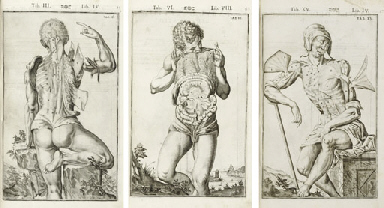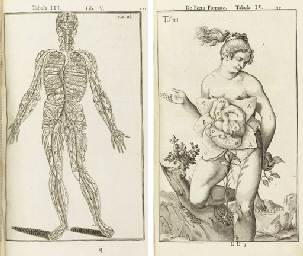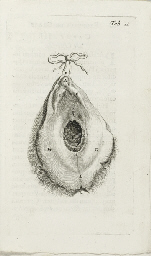MORGAGNI, Giovanni Batista (1682-1771). The Seats and Causes of Diseases Investigated by Anatomy . Translated from the Latin by Benjamin Alexander. London: A Millar, T. Cadell, and Johnson and Payne, 1759.
MORGAGNI, Giovanni Batista (1682-1771). The Seats and Causes of Diseases Investigated by Anatomy . Translated from the Latin by Benjamin Alexander. London: A Millar, T. Cadell, and Johnson and Payne, 1759. 3 volumes, 4 o (259 x 211 mm). (Some occasional spotting.) Modern buckram, 19th-century morocco spine labels, edges stained yellow. FIRST EDITION IN ENGLISH. [ With: ] MORGAGNI. De sedibus, et causis morborum per anatomen indagatis libri quinque . Padua: Remondini, 1765. 2 volumes in one, 2 o (372 x 225 mm). Half-title in vol. I, title-page of vol. I printed in red and black. Engraved frontispiece portrait by Jean Renard and engraved vignettes on title-pages. Contemporary calf (rebacked, some wear at edges). Provenance : M. Blake (signature dated "1792" on half-title); Taunton and Somerset Hospital Library (bookplate); John Farquhar Fulton (1899-1960), American neurophysiologist and medical historian (bookplate). Second edition in Latin. Morgagni was the first to make a complete and systematic correlation between the symptoms of a particular disease and the anatomical lesions found on post-mortem examination. Likening the body to a complex of organic machines, a concept promoted by Malpighi, Morgagni reasoned that the clinical manifestations of a disease could be traced to a breakdown somewhere in the organism, which could then be investigated anatomically. His treatise consisted of approximately 700 case histories and post-mortems, with no illustrations. At this time no illustrations were expected in a treatise on pathology. The first atlas of pathological illustrations would not be published until Matthew Baillie issued his A SERIES OF ENGRAVINGS, accompanied with explanations, which are intended to illustrate the morbid anatomy of some of the most important parts of the human body (1803). See Dibner, 125; See Garrison-Morton 2276; 2734; 2885; NLM/Blake 312; See PMM 206. (4)
MORGAGNI, Giovanni Batista (1682-1771). The Seats and Causes of Diseases Investigated by Anatomy . Translated from the Latin by Benjamin Alexander. London: A Millar, T. Cadell, and Johnson and Payne, 1759.
MORGAGNI, Giovanni Batista (1682-1771). The Seats and Causes of Diseases Investigated by Anatomy . Translated from the Latin by Benjamin Alexander. London: A Millar, T. Cadell, and Johnson and Payne, 1759. 3 volumes, 4 o (259 x 211 mm). (Some occasional spotting.) Modern buckram, 19th-century morocco spine labels, edges stained yellow. FIRST EDITION IN ENGLISH. [ With: ] MORGAGNI. De sedibus, et causis morborum per anatomen indagatis libri quinque . Padua: Remondini, 1765. 2 volumes in one, 2 o (372 x 225 mm). Half-title in vol. I, title-page of vol. I printed in red and black. Engraved frontispiece portrait by Jean Renard and engraved vignettes on title-pages. Contemporary calf (rebacked, some wear at edges). Provenance : M. Blake (signature dated "1792" on half-title); Taunton and Somerset Hospital Library (bookplate); John Farquhar Fulton (1899-1960), American neurophysiologist and medical historian (bookplate). Second edition in Latin. Morgagni was the first to make a complete and systematic correlation between the symptoms of a particular disease and the anatomical lesions found on post-mortem examination. Likening the body to a complex of organic machines, a concept promoted by Malpighi, Morgagni reasoned that the clinical manifestations of a disease could be traced to a breakdown somewhere in the organism, which could then be investigated anatomically. His treatise consisted of approximately 700 case histories and post-mortems, with no illustrations. At this time no illustrations were expected in a treatise on pathology. The first atlas of pathological illustrations would not be published until Matthew Baillie issued his A SERIES OF ENGRAVINGS, accompanied with explanations, which are intended to illustrate the morbid anatomy of some of the most important parts of the human body (1803). See Dibner, 125; See Garrison-Morton 2276; 2734; 2885; NLM/Blake 312; See PMM 206. (4)















Try LotSearch and its premium features for 7 days - without any costs!
Be notified automatically about new items in upcoming auctions.
Create an alert